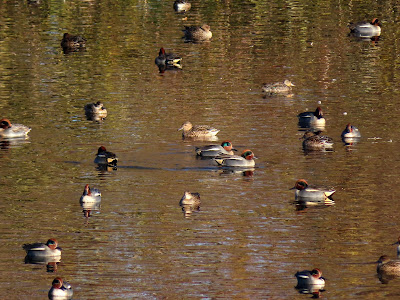Along the Strood seawall a marsh harrier, common buzzard, stonechat and two rock pipits were noted, while of interest in the channel were 27 avocets, 46 shelduck and 100+ wigeon.
A female blackcap and coal tit were at feeders in the Firs Chase garden.
At Maydays on Tuesday at least 15 pintail, maybe up to 40, were seen in the Pyefleet channel by Steve Entwistle.
On a clear sunny visit to the north side of the Island at Maydays farm on Monday 30th, eight pintail were of note at the top end of the Pyefleet Channel. Also along the channel were 6 red-breasted mergansers, 4 great crested grebes and 80 avocets.
The sunny weather on Monday at Maydays brought the buzzards out with five being seen on the Island and another five on the Langenhoe side. Most birds just spending time on exposed perches on tree tops or on bushes. Two marsh harriers also seen and 100 golden plover passing overhead.
Small birds included a pair of stonechat, single fieldfare, 2 yellowhammer, 10 reed buntings, 15 chaffinches and 5 meadow pipits.
A shag was photographed by Shaun Mills in Besom Fleet on Monday morning, later one, possibly two shags seen by Steve Entwistle, also a kingfisher seen perched on Cobmarsh Island and a rock pipit on St Peters. Jim Hume reported seeing 3 great northern divers and a Mediterranean gull from the Esplanade on Monday
On Sunday 29th offshore from West Mersea, 2 great northern divers and five common scoters were seen by Andy Field.
On Saturday 28th a handful of redshank was roosting on the small pond at Waldegraves Holiday park during the high tide. Offshore two great northern divers were feeding close in to the bottom of Cross Lane and 50 sanderling were roosting on the offshore shingle island. Further east 4 Slavonian grebes and 140 great crested grebes were also seen offshore from Coopers Beach / Rewsalls.
Three great northern divers were seen on Saturday offshore from Seaview Avenue by David Curle.
A group of brent geese were on the new boating lake being created beside the Youth Camp, also 8 Mediterranean gulls, 2 shoveler, 30 ringed plover and a pair of stonechat.
Three great northern divers were seen on Saturday offshore from Seaview Avenue by David Curle.
A group of brent geese were on the new boating lake being created beside the Youth Camp, also 8 Mediterranean gulls, 2 shoveler, 30 ringed plover and a pair of stonechat.
Two foxes were prowling along the edge of a field near Cross Lane on Saturday 28th. Also here was a flock of 50+ chaffinch while 20 meadow pipits fed in the field.
A sanderling was feeding with some turnstones on the beach at St Peters on Friday 27th. Later a flock of 30 sanderling was gathered on Cobmarsh Island as were ten bar-tailed godwits.
A locally rare red-necked grebe was first seen late Friday morning by Steve Grimwade and was later seen from St Peters drifting out on the receding tide. At one point it flew further west towards the entrance of Tollesbury Creek but luckily could still be watched with the water being flat calm.
Also offshore from St Peters were a great northern diver, red-throated diver, two common scoter, pair of eider flying west and ten red-breasted mergansers. A kingfisher perched on a mooring rope on Cobmarsh, while rock pipit, little egret and a pair of reed bunting were on St Peters marsh.
Steve Grimwade also noted on Friday 2 great northern divers, 2 great crested grebes, 4 Mediterranean gulls, an eider and two red-breasted mergansers.
On Thursday 26th a kingfisher flew across one of the Strood fields then along the dyke, the pair of stonechats still by the dyke, two common buzzards flew over from Ray Island, marsh harrier, 2 rock pipits, 10 reed buntings and 10 meadow pipits also noted.




















































